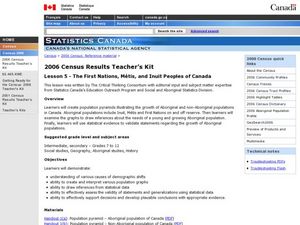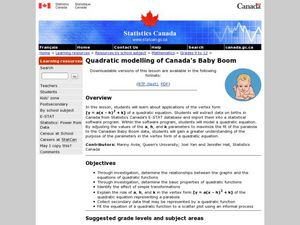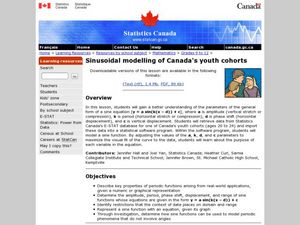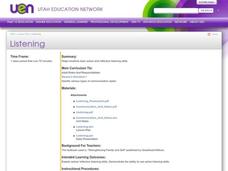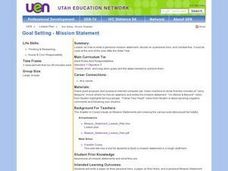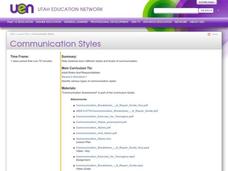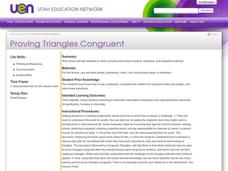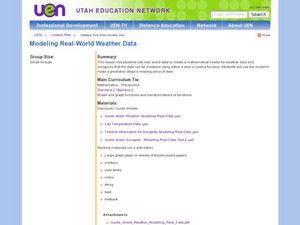Curated OER
Figure Analysis
Learners review the elements of design and how they relate to fashion. Individually, the perform a self-analysis on their body type and identify the appropriate clothing type. To end the lesson plan, they sketch their own clothing...
Curated OER
How Many Ways Can You Represent a Number?
Students participate in monthly scaffolded lessons that focus on working with whole numbers from 1 to 10. They work with tiles on exploration mats, number tile mats, and a number representation book. Each month they complete activities...
Curated OER
Producing and Consuming
Second graders make a booklet. In this economics lesson, 2nd graders define producers and consumers. They make an assembly line accordion booklet to demonstrate how producers and consumers work together to make and use goods.
Curated OER
Identifying potential target markets
Students analyze data. In this secondary mathematics lesson plan, students identify the demographic, geographic, and socio-economic characteristics of potential target markets for planned goods and services. Students identify and...
Curated OER
Chinese Immigrants in British Columbia, 1870
Students interpret historical evidence presented in primary and secondary resources. In this British Columbia history lesson, students read and analyze data regarding 1870 Canadian census data. Students...
Curated OER
The First Nations, Métis, and Inuit Peoples of Canada
Learners explore demographic shifts. In this Canadian Census lesson, students interpret data from the 2006 Census to determine the needs of the Aboriginal population in the country.
Curated OER
Gender and Income
Students investigate Income and gender preference. In this statistic lesson, students collect data of Income to see if one gender makes more than the other. Students examine the data and draw conclusions.
Curated OER
Quadratic Modeling Of Canada's Baby Boom
Students model quadratic equations. In this algebra lesson plan, students are given data to graph using a function. They investigate vertex and transformation of quadratic functions.
Curated OER
Sinusoidal modelling of Canad'a youth cohorts
Students explore the general form of the sine equation. In this trigonometry instructional activity, students explore the relationship between the changing parameters and the graph of the sine equation. Students use data and a...
Curated OER
Over the Borderline?
Young scholars study President Bush's proposal for immigration policy in the US and examine various perspectives on immigration that are currently being debated. They read and discuss an online New York Times article.
Curated OER
Simple Machines
Third graders are introduced to the six types of simple machines and discover how they make tasks easier. In groups, they rotate between stations to experiment with the different types of simple machines. To end the lesson, they make a...
Curated OER
Human Reproduction
Pupils are introduced to the vocabulary related to the male and female reproductive organs. In their journals, they write down the importance of knowing the correct terms of these organs. To end the instructional activity, they...
Curated OER
Listening
Middle schoolers discuss the importance of good listening skills. In groups, they participate in various scenerios in which they practice reflective and active listening. To end the lesson, they complete a listening quiz and compare it...
Curated OER
Child Care -- Arts and Crafts
Students continue their completion of the child care internet course. In groups, they examine the differences between arts and crafts and develop their own stations for their classroom. To end the lesson, they create their own art...
Curated OER
Fibers and Fabric
Students are introduced to a variety of different fibers. After acting out a short story, they discover how yarn and basic weaves are made. To end the lesson, they practice making their own weave pattern using paper strips and then yarn.
Curated OER
First-Aid and Emergencies
Students complete a pre-test to determine what they already know about what to do in an emergency. In groups, they read real-life scenerios and decide what the proper way to handle the situation. To end the lesson, they present their...
Curated OER
Goal Setting -- Mission Statements
Students read examples of mission statements related to goal setting. Individually, they research accomplishments of their hero and how they overcame fear. To end the lesson, they write their own mission statement on how they plan to...
Curated OER
Human Development
Students are introduced to the stages of human development. In groups, they research the theories of Erickson, Maslow and Havighurst and compare them to one another. To end the lesson, they present their material to the class and...
Curated OER
Mystery Recipe Lab
Students engage in a lesson that is concerned with the concept of cooking a new recipe. The book "Cook-a-Doodle-Doo" is used to create the context for the lesson. They use the ingredients and recipe in the lesson and work in groups in...
Curated OER
Communication Styles
Young scholars access different style and levels of communication. They define the levels of communication and assess personal communication styles. Students write in a journal their different views of the styles covered within this lesson.
Curated OER
Teaching With the Power of Objects
Students define value of an object. In this value lesson plan, students identify reasons for collecting objects, compile a personal inventory of items they find valuable, and then define why those items are valuable to them. In step two...
Curated OER
Designing a Fort
Students explore the concept of right triangles. In this right triangle lesson, students construct a scale model of a tourist attraction similar to Fort Jefferson. Students research aerial photos of Fort Jefferson, then build their...
Curated OER
Proving Triangles Congruent
Students examine Triangle Congruency. In this measurement comparison lesson, students use inductive, deductive and analytical thinking skills to prove triangle congruency. Students analyze and record their findings on activity worksheets.
Curated OER
Creating a Mathematical Model Using Weather Data
Students explore the concept of mathematical models. In this mathematical model lesson, students create a mathematical model from data from 4 cities over 15 months. Students are told they are working for a weather station. Students...







